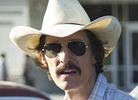
I just had the pleasure of a six-week sojourn in Mexico, my first such massive vacation in about 20 years. But it wasn't all fun and games - I was also there to make acquisitions for my Herb Museum in Vancouver.
Sadly, the cannabis culture in Mexico is still highly underdeveloped, suffering from a ubiquitous stigma and repressive police culture in most places. The tourist town - Valle De Bravo, on the shores of Lake Avándaro - that I was situated near had no head shop or hemp store. It only had a single pot-leaf graffiti that was mostly painted over. The only evidence of any cannabis culture I came across in my travels was in Cordoba - a head shop with a few t-shirts, some pot-leaf earrings and rolling papers, a few pipes and a tiny, pathetic bong. It was really a crystal/saint/UFO/incense shop with a few cannabis-related items thrown in.

The marijuana in Mexico wasn't anything to write home about either. It was dark green with no visible trichomes to speak of, spindly, with the smell of lawn trimmings and a taste ranging from hay to dirt. Every toke I took made me feel lucky to live in Vancouver. We cut it with damiana to make it taste better.
Speaking of damiana (Turnera diffusa), I did manage to get my hands on some tea and a few bottles of damiana liquor. If you don't know about damiana, it's a herb that boosts testosterone. The dried herb mixes well with cannabis, and has a sweet taste to it. The liquor is delicious, and makes everything "just swell" in both men and women. It's like nature's mild Viagra, with no blue-tinted vision or hospital-visit precipitating erections. It comes in a beautiful bottle in the shape of a naked, pregnant lady. The liquor is given by mothers-in-law to their daughters-in-law on their wedding nights, as the story goes, to help with the creation of grandchildren. The museum has several 100-year-old damiana bottles in the aphrodisiacs section; this herb has been popular for a while.
The second item I brought back for the museum was a "molinillo," a special wooden whisk for making Mexican hot chocolate. It's simple: Heat milk to a near-boil, then take shavings from a block of solid chalking chocolate and whisk them up into a frothy, heavenly beverage. The chocolate section of the museum was in desperate need of more artifacts, having only an old tin and some chocolate-coated pharmaceuticals.

I found a peyote-related artifact as well. It's a ceramic diorama of a shaman in the desert surrounded by various cacti, including peyote buttons, made most likely in the '90s. I took it to a sculptor in Vancouver who agreed to do the necessary repairs to some of the cacti and the shaman's feather hat, which had pieces broken off over the years. Aside from a first edition of Huxley's Doors of Perception, the museum has exactly zero peyote-related artifacts so I'm very excited about this particular exhibit.
I didn't come across any ayahuasca artifacts, but did visit an ayahuasca retreat, complete with a ceremonial brick hut and six washrooms, so you wouldn't have to wait in line to "purge." Check out our ayahuasca whistle in the museum.
I had a chance to visit the massive Sonora marketplace in Mexico City, famous for it's herbal medicine merchandise. While unsuccessfully searching for damiana seeds, I did come across and obtain a small statue of Maximon - a Mayan god who has been transformed into the outlaw Catholic saint of gamblers and drunkards, offering aid "in matters of love, health, and money."
Finally, I did manage to pick up a couple of books about the drug war in Mexico. According to Wikipedia, it's resulted in 100,000 deaths, due to the fight over the possible $50 billion black market revenue stream. Drug prohibition is criticized openly in documentaries such as the recent Hecho En Mexico; I managed to pick up a copy at one of the many pirate video outlets on every street.
Still, blame continues to be placed squarely on the Latin American cartels, as is evidenced by the vast number of books, documentaries and made-for-TV-docudramas available in Mexico focused on Pablo Escobar. Overlooked is the role of the CIA as Escobar's biggest customer (dwarfing their suppliers many times over), outlined in books I had brought with me to read, such as Defrauding America by Rodney Stich, which, on page 313, outlines how the CIA called the meeting in late 1981 that first formed the Medellin cartel together in order to make CIA smuggling operations run more smoothly. Or how about page 65 of The Conspirators by Iran Contra insider Al Martin, which describes how Oliver North created a smuggling operation that flew 50,000 kilos of cocaine into the U.S. every month - single-handedly bringing the price per kilo down from $30,000 to $15,000 between 1985 and 1986? Such facts have yet to make it into the mass media or collective consciousness of Mexico, the United States or Canada.
If such facts became common knowledge, who knows how fast drug policy would be transformed from one that benefits elites at the expense of the people, to one that benefits the people at the expense of elites. I'm hopeful that, as the world learns about each and every herb, their proper use, the black market harms, and the corruption and waste that go hand in hand with every drug prohibition, sometime in the near future the truth will win out, and all drugs will be legal, regulated and used to maximum benefit.






